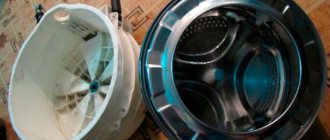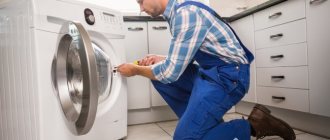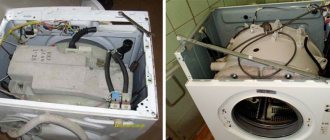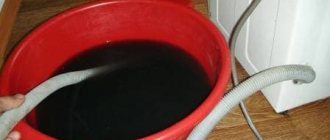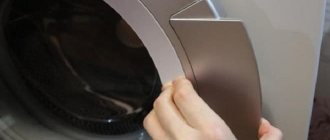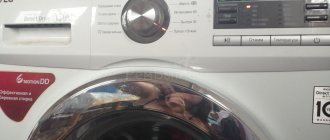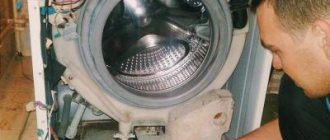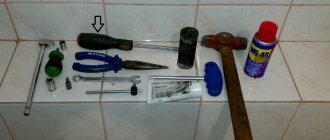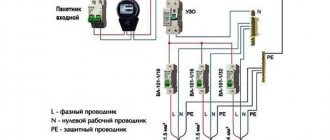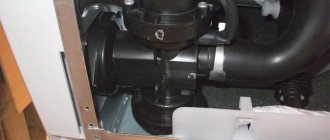Removing the element from the body
Repairing a suspended door is a troublesome and extremely inconvenient task. It’s better not to complicate your task and remove the hatch from the body along with the hinges. This is done simply:
- remove the outer clamp on the hatch cuff;
- we fill the seal inside the drum (it is not recommended to completely remove the rubber band, since returning it to its place is difficult and time-consuming);
- We find one retaining bolt near each door hinge;
- take the key that fits head number 8.
- completely unscrew the bolts.
Be prepared for the door not to come off right away. In addition to the removed bolts, it is also secured with special hook holders. To free the hatch from them, you need to carefully lift the hinges 4-5 mm up, and then pull them towards you. If everything is done correctly, the door will easily leave the grooves.
When removing the door, be extremely careful: the locking hooks are made of plastic and can break off under strong pressure.
Cautions
When the washing machine door is locked, you may want to open it as quickly as possible. At this stage, serious damage to equipment is possible.
To avoid them, you should remember a number of prohibitions:
- If the hatch is locked, then you cannot pull or pull the handle with force. There is a risk of damage to the hatch.
- Do not try to force the door open using a crowbar, large screwdriver, or other rough tool. Such unjustified actions can lead to breakage of the hatch, damage to the cuff and deformation of the machine itself.
- If there is any doubt about the serviceability of the door mechanism, it should be addressed. The problem should not be left “for later”.
- Do not try to open the door before the water has drained from the machine.
Why remove the manhole cover?
Before you start repairing a door, it is worth studying its structure and mounting features. As a rule, all washing machine manufacturers adhere to the same design. But each model has its own characteristics that must be taken into account when carrying out any work. We also make sure to study the electrical diagram and try to determine the nature of the malfunction before disassembling. There are enough reasons to replace the door or its components:
- broken glass;
- latch that does not work or sticks;
- sagging hinges;
- failure of the hinge support.
In addition to the glass, lock and hinges, the UBL can also fail. The hatch locking device is located separately on the washing machine body, but plays an important role in closing the drum. Now we will analyze each breakdown and necessary repairs in more detail.
Preparing for work
To troubleshoot, you must:
- find out the characteristics of the SMA and, in particular, the door itself;
- clarify the basic requirements that will have to be observed during repairs;
- prepare tools;
- buy the necessary materials and spare parts (original versions);
- if the need arises, be prepared to manufacture the necessary elements yourself.
Having outlined an algorithm for your own actions, you need to think through every step so that the washing machine door becomes operational again.
Looking at the locking device
You can guess that the UBL is malfunctioning by several telling “symptoms”. The most important thing is that the machine will display the corresponding error. A door that does not open at the end of the cycle or does not lock when closing also indicates problems with the electronic locking.
To remove and check the functionality of the UBL, you need to remove the device from the housing. But first, you should prepare some tools: a flathead and Phillips screwdriver, a multimeter and a double wire. The latter must have terminals on one side and a plug on the other for connecting to a 220-volt outlet.
Now we remove the UBL from its seat through the top cover of the washer. You can also get the device through the drum, but, we repeat: it is better not to touch the hatch cuff.
- Disconnect the washing machine from the power supply and water supply.
- We unhook the drain and inlet hoses from the machine.
- We provide free access to equipment by moving it away from the wall by 0.5-1 m.
- Loosen the bolts holding the housing cover and remove it.
- We find the fasteners that secure the UBL, which are located directly behind the door lock, and unscrew them.
- We put our hand through the top to the UBL and, holding it with the other hand, disconnect it from the supplied wiring.
- We take out the device.
Next, we begin to diagnose UBL. We take a multimeter, set it to measure resistance and apply the probes to “zero” and “phase”. Then we evaluate the result on the scoreboard: if a three-digit number is shown, then there are no problems with blocking.
Now, using a thin screwdriver, switch the UBL to the “Open” position and connect the device to the socket through the wire. If the mechanism works and a click is heard, then there are no complaints about the performance of the blocker. It doesn’t hurt to attach probes to the neutral and common contacts. The part is operational when “0” is displayed on the display.
Manual opening methods
When choosing what to do when the door is blocked, you need to determine whether there is water inside the tank. If there is water, it must be drained.
The best option is to select the “drain” mode after restarting the washing machine. also use the emergency water drain through the service hatch at the bottom of the washing machine.
If the hatch door is locked using the “child lock” service, then it should be unlocked using the appropriate key combination (information is in the instructions for the washing machine).
Reboot
If the reason for the doors being blocked is a random failure, for example due to a power surge, you should try to reboot.
To do this, the device is disconnected from the electrical network for a period of 20 to 60 minutes and turned on again. This may restore operation of the door lock.
You can also try to start a new washing mode with spin and monitor the program. If the hatch is still blocked, you will have to force it open.
Rope, wire
You can open the hatch without disassembling the washing machine. To do this, you must use a tool that allows you to pry the lock tongue. It is convenient to carry out such work using a wire of sufficient length to go around the door and still have free ends that are convenient to grasp.
Procedure:
- Choose strong thin wire.
- Place it behind the door around the perimeter so that the free ends are on the side opposite the lock, and the wire itself passes between the door and the front part of the washing machine. The resulting loop should fit onto the lock tongue.
- Gently, but firmly enough, you need to pull the loose ends until you hear a click.
- The tongue pryed in this way will come out of the groove and the door will open.
Bank card
If you don’t have a cable or rope at hand, you can open the door using an old bank card.
Partial disassembly of the Indesit washing machine
There is another way to gain access to the hatch door lock - from inside the washing machine. This option is more labor-intensive, since you will have to partially disassemble the device.
Procedure:
- remove the top cover - to do this, unscrew the bolts holding it and push it towards the rear wall;
- you need to reach the locking device through the top of the washing machine;
- you need to press the latch - do this conveniently with a long narrow object;
- the hatch opens.
Removing the back cover requires special care, since the fasteners are plastic and can easily be broken.
Repairing the locking mechanism
If the door does not close tightly, then there is suspicion of deformation of the latch lever. More precisely, irregularities appear on the part, which prevent the hatch from being fixed in the locking mechanism. It's easy to fix the situation:
- remove the door according to the algorithm described above;
- unfold the hatch with the latch towards you;
- take a file and grind off all the existing nicks and irregularities;
- lubricate the surfaces with graphite lubricant for prevention;
- we return the door to its place.
You must handle the hatch door with extreme care: do not hang wet things on it and do not allow children to “ride” on them.
When problems with closing the hatch are caused by sagging hinges or loose fasteners, you need to adjust the position of the door hinges. But here everything is determined by eye: we twist and tighten the fasteners until they fit completely into the grooves.
Prevention measures
In order to avoid problems with the door, you must adhere to preventive measures:
Do not allow items of clothing from the drum to fall into the lock when closing the door.- The drum should not be filled to capacity. In this case, increased load will be placed on all elements of the washing machine. In addition, the likelihood of laundry getting caught in the lock increases.
- The washing machine should be used in conditions without voltage surges. If the voltage in the network is not stable, it is necessary to connect the equipment through a stabilizer.
- If the hatch handle does not work perfectly and does not press the lock mechanism properly, the washing machine needs repairs before it completely jams.
Fixing the glass problem
Broken, broken or cracked glass will prevent you from continuing to use the washing machine. To continue washing, you will have to either replace it or seal it securely. Unfortunately, the replacement option is not suitable for all machine models. More often, the user has to seal the cracks or go to the store for new equipment. Fortunately, it is not difficult to cover up cracks in glass if you follow the instructions.
- Tape the plastic film on the outside without any gaps or voids.
- Place reinforcing tape on the inside of the damage.
- Prepare an epoxy resin solution. Mix the resin and hardener until smooth in a ratio of 6 to 4 based on EDP glue. The consistency of the mixture should be like thin sour cream. If it turns out thicker, then heat it in a water bath, stirring occasionally.
It is better to seal cracks using an epoxy resin solution, since special sealants are washed out over time and leak.
- Fill all cracks and cracks with the resulting resin solution.
- Wait 24 hours.
- Remove the polyethylene and clean out any irregularities on the glass.
It is important to observe the timing and ratio of ingredients when using a resin and hardener solution. Otherwise, the protection will not last as long as desired.
Repairing the handle
Repairing or replacing a door handle is different. The removed hatch must be placed on a flat surface and all bolts around the perimeter must be unscrewed . Next, we will half the structure and remove the glass.
The next step is to repair the support:
- drill a hole of about 3.8-4 mm on the part;
- cut the nail to the appropriate depth;
- heat the sawn nail and insert it into the hole;
- We wait a few minutes and check the integrity of the support.
Follow the operating instructions for the washing machine and read the instructions before using it for the first time.
It is better to avoid problems with closing the door. To do this, it is enough to operate the washing machine carefully, do not tug the handle too much and do not clap when locking the drum. Careless handling leads to premature wear, sagging and breakdowns, which are not difficult to fix, but quite troublesome.
The door of the washing machine is broken: how to remove and disassemble
The loading hatch door is a CMA part through which the laundry intended for washing is placed into the drum. At first glance, it seems that its device does not cause any difficulties, and there should be no breakdowns. But frankly, technicians at washing machine service centers are faced with the problem of door failure quite often. Often the problem lies not in manufacturing defects, but in violation of the operating conditions of the machine. In this article you will learn how to repair a washing machine door yourself.
Typical faults
Before starting repairs, study the structure of the door and the features of its fastening. What problems happen:
- Glass breaks.
- The latch does not work or, on the contrary, gets stuck.
- The support on the hinge breaks.
- The hatch locking device (UBL) does not work.
If the damage is mechanical, you can carry out repairs yourself. But it happens that a failure occurs in the control unit - then the door also does not lock. It is better to entrust the diagnosis and repair of the unit to a professional.
Why the door in the washing machine does not lock and how to fix the problem
All washing machines have a device responsible for blocking the hatch. This ensures complete safety of the device, as it protects against sudden opening of the door during washing, splashing water on the floor and other troubles. There are several reasons why the washing machine door does not close. In some cases, you can deal with the problem on your own, in others you will need to call a specialist. The main thing is to promptly recognize the nature of the malfunction and begin repairing the washing machine.
Repairing damage
Immediately prepare the necessary tools and materials:
- Phillips and slotted screwdriver.
- spare parts for replacement (lock, tongue, spare glass).
UBL repair
Can't open the hatch after washing? The UBL lock may have broken. Since it runs on electronics, check to see if the lights in the apartment have been turned off. In this case, the door will remain locked.
The operating principle of the UBL is simple: the control module supplies electric current to the lock plates. When heated, they bend and press on the latch, which latches the hatch.
How to understand that the device is broken? According to these signs:
- After turning off the machine, the hatch does not open.
- When you start the wash, an error code appears on the screen.
- You've loaded laundry, but the lock won't lock.
To make sure that the problem is in the device and not the control board, you need to carry out diagnostics with a multimeter.
- Attach the tester probes to the “neutral” and “lock phase” contacts.
- Measure the indicators.
- Everything works if three numbers are shown on the screen.
- Then attach the probes to the “neutral” and “common” contacts.
- Zeros or one on the screen indicate a breakdown.
To open the door when locked, you can use the method suggested by our users. Take a thin ribbon and thread it between the SMA body and the hatch. Holding the ends on both sides, pull the tape towards you. After opening, you can begin repairs.
How to fix it yourself:
- Pull back the cuff.
- Using a screwdriver, remove the clamp. If it is plastic, remove the latch.
- Remove the bolts that hold the device in place.
- Tuck the cuff in and remove the lock.
- Disconnect the wiring.
- Install the new part in reverse order.
Replacing the latch
Over time, the latch lever becomes deformed and irregularities appear on it, which interfere with normal closure. To perform the replacement, you need to know how to remove the door:
- Remove the clamp and rubber cuff. If you don’t want to remove it completely, bend it back and tuck it inside.
- On the side you will see the door mounts.
- Remove two screws.
- Lift the hatch up and remove it from its seat.
To return the latch to a smooth surface, you will need a file - grind off the nicks and irregularities. Lubricate parts with graphite lubricant for better performance. Lock the door in its original place.
The reason for the drum not closing tightly may be sagging hinges or loose fastenings. When installing the hatch in place, you need to adjust its position so that the latch fits normally into the hole.
Glass replacement
It’s good if the glass in your SMA model can be replaced, but such luck is rare. Otherwise, you will have to seal the cracks.
- On the outside you need to attach plastic film with tape. It is important that there are no gaps.
- Apply reinforcing tape to the damaged part.
- In a separate container, prepare a solution of epoxy resin.
- Fill the gap with solution.
- After 24 hours, remove the film. Remove drips with sandpaper.
How to prepare resin? To ensure that the product has good adhesiveness and resistance to temperature changes, a hardener is added to the composition. You can prepare a solution based on EDP glue:
- Take 6 parts resin and 4 parts hardener.
- Mix in a separate container until smooth.
- If it turns out too thick, heat it a little in a water bath.
Read the instructions carefully before diluting: an error in the ratios will affect the quality of the resin.
In some cases, a special sealant can be used, although it will not last as long.
Adjusting or replacing the plastic support
To do this, you need to remove the door, disassemble the handle and repair the support.
- Remove the hatch. Place it on a flat surface.
- Unscrew the fasteners around the perimeter.
- Remove the top and glass.
- Now you can remove and replace the handle if it breaks.
- Remove the repair support and drill a hole with a diameter of 3.8 mm in it.
- File the nail to the desired length. Heat it up and thread it through the hole.
- Wait for it to cool down for 2-3 minutes.
To avoid breaking the handle or other elements, do not pull it hard when opening it. Also close the hatch carefully, do not slam the door. Otherwise, the elements will quickly wear out and break.
Now you know how to make repairs yourself. Follow the operating instructions and read the instructions before turning on. Then the equipment will last for many years.
The main reasons why the door does not open
Problems with the washing machine door do not always indicate a problem. In some cases this is even a normal situation, in others it will take some effort.
Reasons for blocking the hatch door on the Indesit washing machine:
- activated (specifically or accidentally) “child protection” mode;
- breakdown of the locking mechanism;
- program failure (for example, due to a voltage drop).
In addition, there may be situations where the washing program has not completed. In this case, water remains inside the tank and the door becomes blocked.
In such a situation, the following reasons need to be considered:
- pump failure;
- lack of electricity supply to the washing machine;
- clogged drain system;
- sewer blockage.
